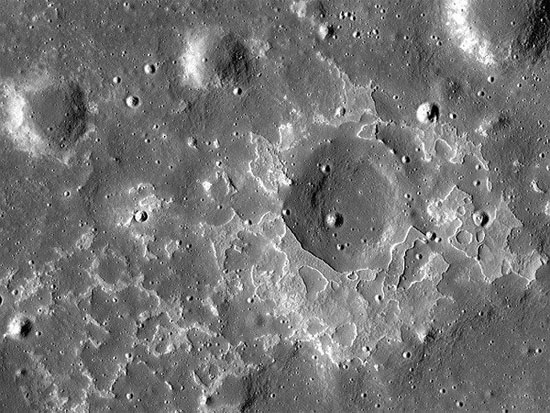At the time of dinosaurs, volcanoes on the Moon used to work?
The moon is a quiet and barren satellite of the earth. But long ago, on the Moon there were volcanoes that were powerful, leaving many 'scars' on its surface.
For decades, researchers still believe that lava flows have flowed on the Moon from about 1 billion years ago. However, according to the Daily Mail, a new study has shown that volcanic activity is still present on the Moon 100 million years ago - an era in which dinosaurs still live on Earth.
If confirmed, this finding could prove the presence of radioactive elements that keep the Moon's core at high temperatures. The discovery comes from images sent by the Lunar Reconnaissance Orbiter (LRO), showing a certain volume of Moon quarries less than 100 million years old.
"This discovery may lead geologists to rewrite all the Moon's basic books," said John Keller, of the LRO project.

Detecting many volcanoes on the surface of the Moon.(Source: NASA)
These quarries are scattered on the surface of the Moon, characterized by smooth, round mounds beside the rugged, rocky terrain. Therefore, scientists call them unusual surfaces .
They are too small to be detected from the earth, with the largest width being only about 0.5km. One of the largest, most researched areas named Ina was photographed by Apollo 15 astronauts.
Ina is considered to be the only unusual array until researchers at Arizona State University in Tempe, USA and Westfälische Wilhelms - Universität Münster in Germany discovered similar arrays in the high-resolution LRO image. send to.
The number and size of these arrays indicate that the end volcanic activities are not an anomaly, but an important part of the Moon's geological history.
Based on a technique involving the size of the craters with samples obtained from Apollo and Luna, two of the unusual arrays are thought to have a lifespan of less than 100 million years, and can be less than 50 million. years in Ina's case.
In contrast, the volcanic plains surrounding these particular plots are thought to have formed as a result of volcanic activity starting 3.5 billion years ago and ending about 1 billion years ago.
This new finding goes against the inherent assumptions made by scientists about the core temperature of the Moon."These young volcanic areas will become the main targets of future exploration , " said Mark Robinson, a key LRO researcher at Arizona State University.
The title has been changed.
- Can accurately guess the time when volcanoes are active
- Discovered 280 new craters on the Moon
- See active volcanoes around the world
- 11/8 watch the latest
- Meteorites make dinosaurs extinct
- 10 weird, hard to imagine dinosaurs
- Suddenly discovered 2 young craters on the Moon
- The cause of dinosaurs extinction
- How big was the moon in the dinosaur era?
- 'Super moon' is about to appear
- New hypothesis about the cause of dinosaur disappearance
- What is super moon? When will Vietnam receive Super Moon?
 Van Allen's belt and evidence that the Apollo 11 mission to the Moon was myth
Van Allen's belt and evidence that the Apollo 11 mission to the Moon was myth The levels of civilization in the universe (Kardashev scale)
The levels of civilization in the universe (Kardashev scale) Today Mars, the sun and the Earth are aligned
Today Mars, the sun and the Earth are aligned The Amazon owner announced a secret plan to build a space base for thousands of people
The Amazon owner announced a secret plan to build a space base for thousands of people This Abundant Mineral on the Moon Could Power Humanity for Thousands of Years
This Abundant Mineral on the Moon Could Power Humanity for Thousands of Years  The Strange Disease That Affects Everyone Who Has Ever Set Foot on the Moon
The Strange Disease That Affects Everyone Who Has Ever Set Foot on the Moon  What would a day on the Moon be like for astronauts?
What would a day on the Moon be like for astronauts?  First photo of Mars' strangely shaped moon
First photo of Mars' strangely shaped moon  The biggest supermoon of the year is about to light up the world's skies
The biggest supermoon of the year is about to light up the world's skies  New research shows that Earth has a new 'Moon'
New research shows that Earth has a new 'Moon' 